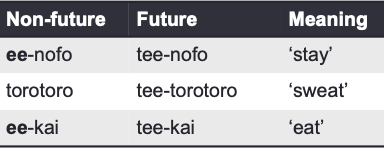Brevity law
The brevity law (Zipf's law of abbreviation): More frequent words tend to be shorter
-
This need not be true in your language, but it's a reasonable law for any communication systems
Minimal words
Some languages have minimal word requirements, e.g. according to Van Urk (lecture notes) nouns and verbs in Imere must have three syllables

This is arguably related to stress (primary stress falls on the antepenultimate syllable in Imere)
Morphological structure
Morphological processes
-
Concatenative morphology
- Affixation (suffix, prefix, infix, circumfix)
- Compounding
-
Non-concatinative morphology
- mutation (ablaut; consonantal, e.g., Welsh)
- Subtraction
- Reduplication
- Portmanteau
- Templaic morphology (see next slide for an example)
'Write' in Arabic

(from Arkadiev 2020)
Allomorphy
Morpholological processes create related words
Allomorphy: The same morpheme might be relalised differently in the same paradigm
- /haʊs/ 'house' vs. /haʊz/-/ɪz/ (hous-es)
- /ɛɡeːr/ egér 'mouse' vs. /ɛɡɛr/-/ɛt/ eger-et 'mouse-acc' in Hungarian
An extreme case of this is suppletion, e.g.
- go vs. went
- person vs. people
- good vs. bett-er vs. be-st
- va-i (go-2sg.pres.ind) vs. anda-te (go-2pl.pres.ind)
Morphophonological rules
Allomophy may involve phonologically conditioned alternations, e.g.
- Assimilation (e.g., in- vs im- in English)
- Dissimilation (e.g., -ālis vs. āris in Latin)
- Vowel harmony (e.g. mektep-te 'school-loc' vs. yighin-da 'meeting-loc' in Uyghur)
- Neutralisation (e.g., /bɛt/ 'bed' vs. /bɛdə(n)/ 'bed-pl' in Dutch; cf. /boːt/ 'boat' vs. /boːtə(n)/ 'boat-pl')
- Epenthesis
- Deletion
See Odden 2005 for more examples
Natural phonological rules
-
Arguably many phonological rules apply to solve phonetic/phonological issues (e.g., neutralise in perceptually less contrastive positions, break consonant clusters, etc.)
-
The phonological change tends to be minimal
Impossible morphophonological rules:
- A neutralisation rule that applies to stressed syllables
- Prefix /in-/ becomes /akof-/ if the following segment is labial
Morphology for your language
-
Your language can obey or disobey the brevity law
-
Your language can be morphologically simple or complex
- If it can be morphologically complex, decide what kind of morphological process to use
- Decide if they should involve morphophonological rules
You'll be asked to make some words and morphemes before Week 5